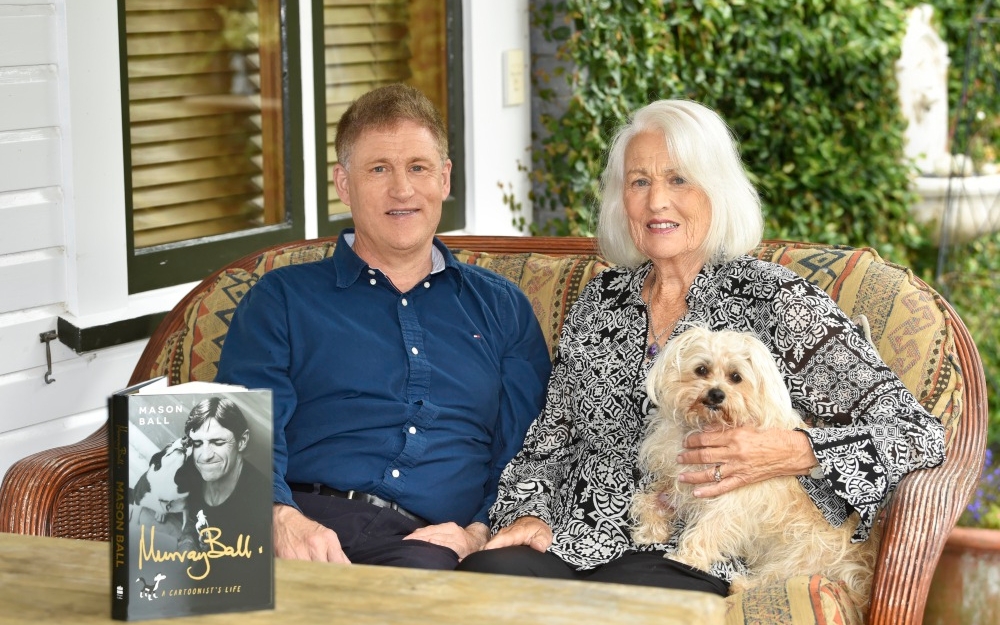For almost 50 years, Footrot Flats has been a part of Kiwi life. The cartoon strip about a dog called Dog is still much-loved by readers, although sadly its creator Murray Ball died in 2017 after a long decline due to Alzheimer’s disease.
Now one of his three children, son Mason, 57, has gathered up memories of this talented man along with some of his cartoons in a biography, Murray Ball: A Cartoonist’s Life.
“I started it on the day he died really,” recalls Mason, an English language teacher who lives with his wife and three children in Wellington. “As the ideas and memories were accumulating, I’d write them down. It was part of the grieving and healing process, just to remember what he’d been like before his illness. At first, it was pretty raw, but over five or six years, it was gradually refined and got better.”
His mother Pam, 83, believes no one else could have written the story of the man she calls “the love of my life”. She says helping Mason and sharing memories has been therapeutic for her too.
“Those last 10 years were hell, to be honest,” she tells. Murray disappeared on me in every way – physically by wandering away and getting lost, and also as a person. We have to think past those days to earlier, happier memories.”
Pam first set eyes on Murray at a garden party in 1963. Only the day before, she’d been to a fortune teller who told her she was going to meet her husband very soon.
“She said he’d be tall, dark with tawny eyes and a lovely smile,” recalls Pam. “I didn’t really believe in that sort of thing, but then this bloke came walking down a slope towards me, and I thought, ‘There he is!’ We sat and chatted – arranged to have a game of tennis, go to the movies – and we never looked back.”

Feeding the hens with Pam.
In the early days of their marriage, things weren’t always easy. Murray tried for a career as a teacher in a Coromandel school, but it didn’t go well.
“He drew pictures on the blackboard and forgot to teach maths,” says Pam. “He’d take the kids off for mock battles in the paddocks and beach walks. They loved it, but the school inspectors weren’t so impressed.”
At that point, Mason was a baby and another son was on the way. To pursue Murray’s dream of cartooning, the family packed up and moved to England. What followed was lots of rejection and struggle as he worked to become established there.
“We’d send out cartoons maybe 15 at a time and they’d come back, rejected, so we’d repack them and send them off again,” says Pam. “We did that for a long time.”
Everyone held on to their faith that Murray could do it and when his cartoon strip, Stanley, about a bespectacled prehistoric caveman, was accepted to run in the satirical magazine Punch, his career was on its way.
It was only after coming back to New Zealand in the 1970s that Footrot Flats was born. The family moved to a rundown rural property near Gisborne and life there provided Murray with endless inspiration.
His wife and son remember him as a very private man, happiest at home surrounded by those he loved, fond of slapstick humour and musicals, with firmly held views and strong values, as well as a tremendous work ethic.
Murray and a young Mason at Mercury Bay, in the Coromandel.
Pam worked alongside him running their business Diogenes Designs, while also raising Mason, his brother Gareth and sister Tanya. Meanwhile, Murray’s career went from strength to strength, with Footrot Flats appearing in more than 200 newspapers, and being turned into a stage play, a movie and even a theme park.
Towards the end of his life, he was still drawing. Mason says he created a beautiful alphabet chart for one of his own sons just a few years before he died.
“You could put a pen and pad on his lap, and ask him to draw pretty much any animal, and 15 minutes later he’d have sketched something beautiful from memory. It was incredible,” he tells.
Part of the reason for writing the memoir was that Mason wanted his father to be remembered for more than Footrot Flats. “There was so much more to him than that.”
Pam still lives in the house they shared on the land that Murray loved and tended.
“He made this a home and for me that’s his biggest legacy,” she says. “We’ve got a hill behind us which is full of the pōhutukawa trees he planted and any minute now they’re going to be like a river of red. In some ways, he hasn’t died for us because his legacy goes on and on.”
Murray Ball: A Cartoonist’s Life (HarperCollins, $45), is out now.
 Rebecca Grunwell
Rebecca Grunwell

